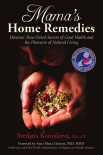Mama's Home Remedies: Discover Time-Tested Secrets of Good Health and the Pleasures of Natural Livin, Svetlana Konnikova [classic fiction .TXT] 📗

- Author: Svetlana Konnikova
Book online «Mama's Home Remedies: Discover Time-Tested Secrets of Good Health and the Pleasures of Natural Livin, Svetlana Konnikova [classic fiction .TXT] 📗». Author Svetlana Konnikova
percent or higher for workers who report stress), and employee turnover. Stress affects physical and mental health, and is linked to a decreased willingness to take on new and creative endeavors, and job burnout, which is experienced by 25–40 percent of U. S. workers. More than ever before, employee stress is being recognized as a major drain on corporate productivity and competitiveness.
Statistics from a recent global stress research study show that increased stress is felt worldwide, and stress affects women differently than men. Women who work full-time and have children under age 13 report the greatest stress. Nearly one in four mothers who work full-time and have children under age 13 feel stress. Globally 23 percent of women executives and professionals say they feel “super-stressed.”32
Don’t Be Afraid of Good Stress @ 185
On spring break from Moscow State University I came home
exhausted. I had undergone a grueling winter session of many exams, which would determine my eligibility to remain in classes for the second half of the school year.
When I arrived at the airport, Mama took a look at me and shook her head in disapproval. I couldn’t blame her. I felt as if all my energy was spent, and as I listened to my body, it sometimes seemed to me that my blood had difficulty circulating through my veins and blood vessels.
“Oh, oh!” I thought while grinning at Mama. “Our family doctor (Mama) has found herself a new patient.” Mama always worried about me and she was always overprotective.
I knew intuitively that I was due for a course of Mama’s vitamin therapy. She frowned at me and said, “Are you running out of energy? I can tell without testing that your hemoglobin level is very low. You need a special course of vitamins.”
“Didn’t I read her thoughts?” I asked myself.
Milk with rose hips jam or rose hips preserves was an “urgent remedy” in Mama’s list of natural treatments. And the manufacturer of those tasty natural remedies was Grandma. Each year Grandma made delicious preserves, jams, and other natural delights from rose hips as well as grapes, plums, strawberries, raspberries, black and red currants, cranberries, cherries, gooseberries, peaches, small “paradise apples,” pears, apricots, green nuts, oranges, and quinces. She cooked exotic preserves from green tomatoes,
green beans, watermelon rind, and pumpkin cooked in
a grape mousse. My favorite, and the most prescribed
by Mama, was rose hips and black currant preserves.
Black currants are an important ingredient in
vitamin therapy. We cal ed these berries Ribes from the Latin, Ribes Nigrum or Chernaya Smorodina. Grandma grew this shrub in her garden. A mediumsized shrub with yel ow-brown shoots, five-lobed leaves, and green-white flowers, this bush bore many berry clusters annual y. This berry is less common in the United States because it can host pine blister rust ( Cronartium Ribicola), which can devastate forests. It is more readily 186 ^ Mama’s Home Remedies
available now because of recent commercial breeding.
Grandma used large, plump berries in her delicious black currant preserves. She combined 32 ounces of honey or two pounds of sugar, 16 ounces of water, and two pounds of black currants. Then she cooked the mixture until it thickened, periodically removing the froth that formed during cooking. It was a tasty preserve that complemented our black or green teas. I always tasted these preserves as soon as she finished preparing them. Just imagine tasting a spoonful of this 100-percent natural, indigo mixture thick with tiny grains of rubbed berries and following it with a sip of hot, aromatic Ceylon tea. It is so delicious!
In shady places throughout Grandma’s garden stood thorny shrubs of rose hips. She plucked fragrant petals from the flowers and boiled them in water for two to three minutes. Then she added lemon juice, covered the mixture with a lid, and steeped it for 15–20 minutes. Then she poured the pink rose juice into a pot with the preserves along with sugar or honey to make syrup. If you’d like to try this recipe, prepare 10 ounces rose hips petals, two pounds sugar or 24 ounces honey, two tablespoons lemon juice, and eight ounces water.
Grandma also made a tasty jam from the raw pulp of rose hips, ground with honey or sugar.
She would cook rose hips berries as a special medicinal preserve, knowing that rose hips contain almost 40 percent of vitamin C, and are, therefore, a valuable vitamin product.
Concoctions, preserves, and jams from wild roses or rose hips ( shipovnik) berries that Grandma had dried herself were also mainstays in our home. Over a campfire in our backyard, she would boil four pounds of fresh berries in their own juice for 10 minutes. She then mashed the berry mixture and cooked it in a water bath until it thickened. Her water-bath method was to sink the small pan containing rose hips pulp into a large pan of boiling water.





Comments (0)